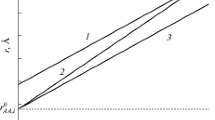Abstract
A statistical thermodynamic theory of short-range order effects in an ordering binary alloy with an arbitrary composition and an arbitrary radius of the interatomic interaction has been constructed in the approximation of ring diagrams for the free energy. For concreteness, a solid solution, which orders according to the Cu3Au type, has been considered. A formula has been obtained for the Fourier components of the correlation parameters, which is valid for a wide range of variation of concentration and temperature of the alloy. Correlation parameters of the system Cu3Au with a stoichiometric composition have been calculated according to this formula for given values of the displacement energy for various coordination spheres at several values of temperature and the interaction radius.
Similar content being viewed by others
Literature cited
M. A. Krivoglaz and A. A. Smirnov, Theory of Ordering Alloys [in Russian], Fizmatgiz, Moscow (1958).
V. I. Iveronova and A. A. Katsnel'son, Short-Range Order in Solid Solutions [in Russian], Nauka, Moscow (1977).
W. A. Harrison, Pseudopotentials in the Theory of Metals, Benjamin-Cummings (1966).
L. I. Yastrebov and A. A. Katsnel'son, Foundations of the One Electron Theory of Solids [in Russian], Nauka, Moscow (1981).
K. I. Portnoi, V. I. Bogdanov, and D. L. Fuks, Calculation of the Interaction and Stability of Phases [in Russian], Metallurgiya, Moscow (1981).
V. E. Panin, Yu. A. Khon, I. I. Naumov, et al., The Theory of Phases in Alloys [in Russian], Nauka, Novosibirsk (1984).
D. A. Badalyan and A. G. Khachaturyan, Fiz. Tverd. Tela,12, 439 (1970).
J. C. Kirkwood, J. Chem. Phys.,6, 70 (1938).
R. Brout, Phase Transitions [Russian translation], Mir, Moscow (1967).
G. Kramer, Mathematical Methods in Statistics [Russian translation], Mir, Moscow (1975).
R. Brout, Phys. Rev.,115, 824 (1959);122, 469 (1961).
A. G. Khachaturyan, The Theory of Phase Transitions and the Structure of Solid Solutions [in Russian], Nauka, Moscow (1974).
M. A. Krivoglaz, Zh. Éksp. Teor. Fiz.,32, 1368 (1957);34, 204 (1958).
P. C. Clapp and S. C. Moss, Phys. Rev.,142, 418 (1966).
A. A. Katsnel'son, Phys. Status Solidi,B51, 457 (1972).
Wu Der-Hsueh and R. A. Tahir-Kheli, J. Phys. Soc. Jpn.,31, 641 (1971).
Yu. S. Stark, A. S. Shteinberg, and V. I. Dimitrov, Fiz. Met. Metalloved.,56, 53 (1983).
J. M. Cowley, J. Appl. Phys.,21, 24 (1950).
S. C. Moss and P. C. Clapp, Phys. Rev.,171, 764 (1968).
Author information
Authors and Affiliations
Additional information
Translated from Izvestiya Vysshikh Uchebnykh Zavedenii, Fizika, No. 8, pp. 62–67, August, 1988.
The authors thank D. M. Sedrakyan and É. M. Kazaryan for a discussion of the results.
Rights and permissions
About this article
Cite this article
Badalyan, D.A., Muradyan, A.A. & Melik-Vartanyan, D.K. Diagrammatic method for the calculation of short-range order effects in an ordering binary alloy. Soviet Physics Journal 31, 659–663 (1988). https://doi.org/10.1007/BF01102545
Received:
Issue Date:
DOI: https://doi.org/10.1007/BF01102545




